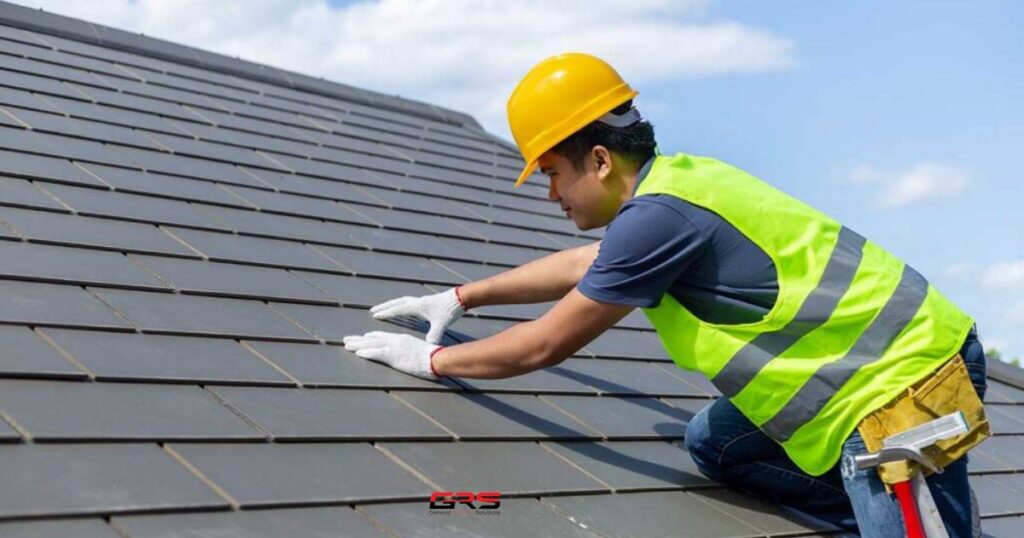Emergency roof repairs can be stressful and daunting, especially when unexpected damage threatens the safety and comfort of your home. Whether it’s caused by a storm, a fallen tree, or sudden leaks, acting quickly is essential to minimize further damage. Here’s a guide on how to handle emergency roof leak repair efficiently and effectively. If you need immediate assistance, contact our expert roofing team for prompt and reliable emergency services.

1. Ensure Safety First
Before you do anything, prioritize safety. Severe weather conditions, structural damage, or electrical hazards can pose significant risks.
Evacuate if Necessary: If the damage is extensive, consider evacuating your home temporarily to avoid any risks.
Turn Off Utilities: In case of severe leaks or structural damage, turning off electricity and water supply can prevent accidents.
2. Assess the Damage
Once it’s safe, conduct a preliminary assessment of the damage. This will help you understand the severity and the type of roof repair needed.
Inspect from Ground Level: Start by inspecting your roof from the ground with binoculars. Look for visible signs of damage such as missing shingles, debris, or sagging areas.
Check the Attic: Look for leaks, water stains, and wet insulation in your attic. This can help you pinpoint the source of the damage.
3. Document the Damage
Documenting the damage is crucial for insurance claims and repair estimates.
Take Photos and Videos: Capture clear images and videos of the damage from different angles. This will serve as evidence for your insurance company.
Keep Notes: Write down details about the damage, including when it occurred and any immediate actions you took.
4. Temporary Fixes
Implementing temporary fixes can help prevent further damage until professional help arrives. Need assistance with temporary roof fixes? Our team is ready to provide emergency roof leak repair services.
Tarp the Roof: If you notice any significant holes or exposed areas, cover them with a waterproof tarp. Secure the tarp with nails or duct tape to ensure it stays in place.
Seal Leaks: Use roofing tape or sealant to temporarily patch small leaks. This can prevent water from seeping in and causing more damage.
5. Contact a Professional Roofing Service
Contact a professional roofing service as soon as possible for a permanent solution.
Emergency Services: Look for roofing companies that offer emergency roof leak repair services. These companies can provide quick response times to address urgent issues.
Licensed and Insured: Ensure the roofing contractor is licensed, insured, and experienced in handling emergency repairs.
Get Estimates: Obtain multiple estimates to understand the scope of work and the associated costs. This can also help you negotiate a fair price.
6. File an Insurance Claim
If the damage is covered by your homeowner’s insurance, filing a claim can help cover the repair costs.
Contact Your Insurance Company: Report the damage to your insurance company as soon as possible. Provide them with the documentation you’ve gathered.
Adjuster Inspection: An insurance adjuster may need to inspect the damage before approving your claim. Ensure you’re available to answer any questions and provide additional information if needed.
7. Prepare for the Repair
Once you’ve selected a roofing contractor and received approval from your insurance company, prepare your home for the roof repair process.
Clear the Area: Remove any valuables and furniture from the areas directly beneath the damaged roof. This can prevent further damage during the repair.
Communicate with the Contractor: Stay in touch with the contractor to understand the timeline and any preparations you need to make.
8. Prevent Future Emergencies
After the repairs are completed, take steps to prevent future emergencies.
Regular Inspections: Schedule regular roof inspections to catch minor issues before they become major problems. Inspect your roof after severe weather events as well.
Maintain Gutters and Downspouts: Keep gutters and downspouts clean and free of debris to ensure proper water drainage.
Trim Overhanging Trees: Regularly trim trees with branches that overhang your roof to prevent them from causing damage during storms.
In Conclusion
Handling emergency roof repairs quickly requires a combination of immediate action, documentation, and professional help. By ensuring safety, assessing the damage, implementing temporary fixes, and contacting a reliable roofing service, you can mitigate further damage and restore your roof effectively. Additionally, taking preventive measures can help protect your roof and home from future emergencies. Remember, when in doubt, always consult with a professional to ensure the best outcomes for your roof repair and home.
If you encounter an urgent roof issue, don’t wait—reach out to our emergency roof leak repair team now. For expert advice and reliable roof repair, call us today and secure your home’s roof against leaks and damage.


